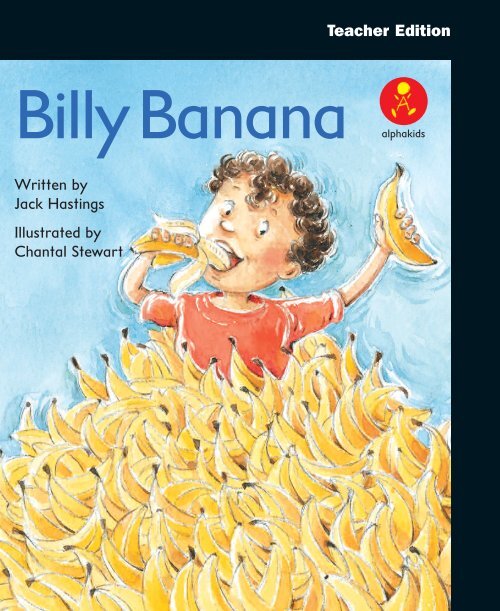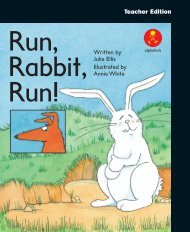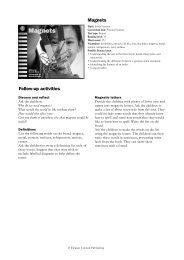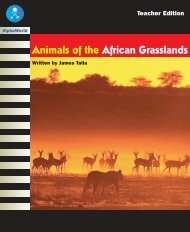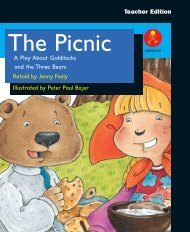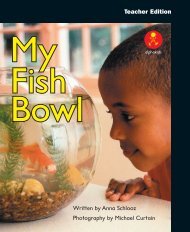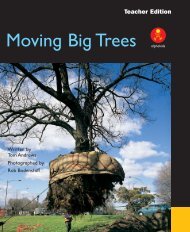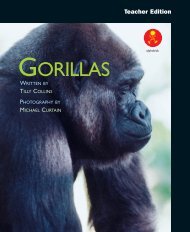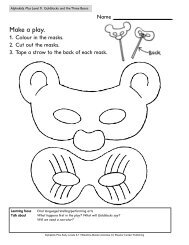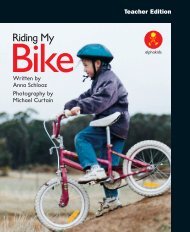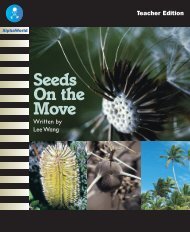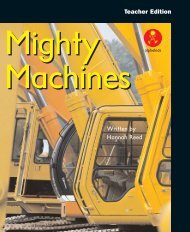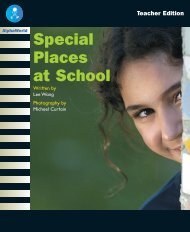Billy Banana
Billy Banana
Billy Banana
- No tags were found...
Create successful ePaper yourself
Turn your PDF publications into a flip-book with our unique Google optimized e-Paper software.
Teacher Edition<strong>Billy</strong><strong>Banana</strong>alphakidsWritten byJack HastingsIllustrated byChantal Stewart
Published edition© Eleanor CurtainPublishing 2004First published 2004Apart from any fair dealing forthe purposes of study, research,criticism or review, aspermitted under the CopyrightAct of Australia, no part of thisbook may be reproduced byany process, or transmitted inany form, without permissionof the copyright owner. Wherecopies of part or the whole ofthis book are made under PartVB of the Copyright Act, thelaw requires that records ofsuch copying be kept and thecopyright owner is entitled toclaim payment.Developed byEleanor Curtain PublishingText: Nicole Di MarcoConsultant: Susan HillDesigned byAlexander StittProduction byPublishing SolutionsPrinted in ChinaISBN 0 7253 3413 41 2 3 4 5 6 7 8 904 05 06?How to use this bookBefore reading: TalkthroughTalk through the book with the children. Encouragethem to predict the text from the cover and thepictures, and to think about the information theyprovide. Direct the children’s attention to aspects ofthe text that may challenge them. Support the childrento deal with these challenges by asking theTalkthrough questions on each page.During reading: Observe and supportObserve the children as they read. Encourage them tomonitor their own reading as they comprehend thetext. As needed, support the children by helping themto discover and use reading strategies and cues to solveproblems and respond to reading challenges that arisein the text. Interruptions to the children’s readingshould be minimal and focused on specified learningneeds.After reading: Comprehension, returning tothe text, responding and writing linksTo further develop children’s understanding of thetext, select from activities found on page 16 and theinside back cover. These whole text, sentence and wordlevel activities reinforce the teaching focus of thisbook. Assessment ideas are provided to assist withplanning for further teaching.Text highlights• Number words are included.• An example of a written list is included.• Colour illustrations support and extendthe text.Vocabularybananas, <strong>Billy</strong>, birthday, dad, five, four, friends,grandma, grandpa, milk shakes, mother,pancakes, sandwiches, school, splits, three, two
Setting the contextWho likes bananas?How do you like to eat them?What are some other ways to eat bananas?Introducing the bookThis book is about a boy called <strong>Billy</strong>, wholiked bananas so much that he didn’t wantto eat anything else.Front coverWhat is unusual about the picture on thefront cover? Could someone really eat thismany bananas?What do you know about <strong>Billy</strong> from lookingat the front cover?Title pageRead the title together.Point out the names of the author andillustrator. Briefly discuss the roles of each.
<strong>Billy</strong> <strong>Banana</strong> Pages 2–3?TalkthroughLook at the picture. What is <strong>Billy</strong>’s mother trying to do? What is<strong>Billy</strong> doing? His grandma says that he’ll start to eat other foodsoon, but what is she feeding him?Do you have a baby brother or sister? What do they like to eat?Observe and supportDo the children check what they read with the phonicinformation on the page? Point out a word such as‘grandma’, and ask the following questions:How did you know what that word was?What did you check at the start of the word?What did you look for at the end of the word?What else did you check?2
<strong>Billy</strong> <strong>Banana</strong> Pages 4–5?TalkthroughNow <strong>Billy</strong> is two years old. What do you think he wants to eat?How can you tell?What does his dad mean when he says, ‘He’ll grow out of it’?Observe and supportDo the children integrate a range of cues whenreading?Point to a word that the child has read correctly.Does that make sense? How do you know?Does it look right?4
<strong>Billy</strong> <strong>Banana</strong> Pages 6–7?TalkthroughNow <strong>Billy</strong> is three years old. What does his mother try to givehim with his bananas?Does he eat the peas?What might his mother be feeling when she says, ‘Oh no!’?Observe and supportCan the children identify an exclamation mark andexplain what it is used for?Can you point to the exclamation mark?What does it tell you when you are reading?How should your voice sound when you read this sentence?6
<strong>Billy</strong> <strong>Banana</strong> Pages 8–9?TalkthroughNow <strong>Billy</strong> is four years old. What does his grandpa try to feedhim? Why? What does <strong>Billy</strong> do?Observe and supportCan the children interpret the text?What does <strong>Billy</strong>’s grandpa mean when he says,‘This is notgood!’?8
<strong>Billy</strong> <strong>Banana</strong> Pages 10–11?TalkthroughNow <strong>Billy</strong> is five years old. Look closely at the picture. Where ishe? What do you think he has for lunch every day? What do hisfriends say?Observe and supportCan the children read the text fluently?Model reading a passage of the text to the children.Have them read it with you.Can you make it sound like I do?Have the children read the text by themselves.10
<strong>Billy</strong> <strong>Banana</strong> Pages 12–13?TalkthroughWhat is <strong>Billy</strong>’s mother doing?The book says that his mother knows what <strong>Billy</strong> wants for hisbirthday party. What do you think she will make?Observe and supportDo the children use a range of strategies to work outnew vocabulary?How did you work out the word ‘birthday’?Can you see some words you already know in ‘birthday’?12
<strong>Billy</strong> <strong>Banana</strong> Pages 14–15?TalkthroughWhat has <strong>Billy</strong>’s mother made? Was your prediction correct?Does the food made from bananas look yummy?What have you learned about <strong>Billy</strong>? Do you like him?Would someone really only eat bananas?Observe and supportDo the children check a range of information on thepage to assist with problem solving?When you looked at the picture before you read the page, whatwere you looking for? How did that help you?What else did you check?14
<strong>Billy</strong> <strong>Banana</strong> Page 16? TalkthroughDo you think <strong>Billy</strong>’s friends like bananas? How can you tell?16After readingBeing a meaning makerEncourage the children to support their responseswith evidence from the book as they discuss thesecomprehension questions:What does <strong>Billy</strong> like to eat?Why does <strong>Billy</strong>’s dad say, ‘He’ll grow out of it’?Does <strong>Billy</strong> grow out of it?Could anyone really like bananas as much as <strong>Billy</strong>?
Being a code breakerExplore the following language features:• High-frequency words: a, all, and,big, for, give, he, his, how, in, is, it,no, of, only, out, said, then, this, to,too, was, we, went, what, when, yes.• Hearing sounds: the children can beasked to listen for the /b/ sound atthe start of words: big, <strong>Billy</strong> <strong>Banana</strong>,birthday, boring.Being a text userRefer to the text when discussing thesequestions.Did you like this book? Why or why not?Who would you recommend this book to?Being a text criticWhy do you think the author called the boy<strong>Billy</strong>?How would the text change if the boy had adifferent name?Responding to textThe children could work incooperative groups to practise andperform a readers’ theatre of the book.Ask the children to select theirfavourite illustration in the bookand to study it closely. Then get them towrite down all the things they know aboutthe story from the picture that are notwritten in the text. Have a class discussionabout the job of an illustrator.The children could list andillustrate words from the book thatstart with /b/. They could browsethrough other familiar texts to add totheir lists.WritingThe children could write a book called101 Things to Make With <strong>Banana</strong>s. Theirideas could be collated to make a classbook.AssessmentCan the children:• identify the words that indicate that the story is in the past tense?• interpret the text to explain whether or not the story could be true?whole text activity sentence activity word activity
alphakidsALPHAKIDS<strong>Billy</strong><strong>Banana</strong>Written byJack HastingsIllustrated byChantal StewartTeacherEditionOtherbooksat thislevelalphakidsCircus BoyWritten by Mary-Anne CreasyPhotography by Michael CurtainTopic: FoodCurriculum link: SOSEText type: NarrativeReading level: 11Word count: 154High-frequency words: a, all, and, big, for, give,he, his, how, in, is, it, no, of, only, out, said, then,this, to, too, was, we, went, what, when, yesVocabulary: bananas, <strong>Billy</strong>, birthday, dad, five,four, friends, grandma, grandpa, milk shakes,mother, pancakes, sandwiches, school, splits, three,twoThe Baby Picnic BearA Play About Goldilocksand the Three BearsGoes for a WalkRetold by Jenny FeelyIllustrated by Peter Paul BajeralphakidsFlyingMachinesWritten by Mary-Anne CreasyGORILLASWRITTEN BYTILLY COLLINSalphakidsPHOTOGRAPHY BYMICHAEL CURTAINPossible literacy focusThe language used to indicate the past tense: ate,when, was, etc.The features of a narrative.SummaryThis book is about a boy who loves bananas so muchthat he doesn’t want to eat anything else.ISBN 0- 7253- 3413- 49 780725 334130alphakids


